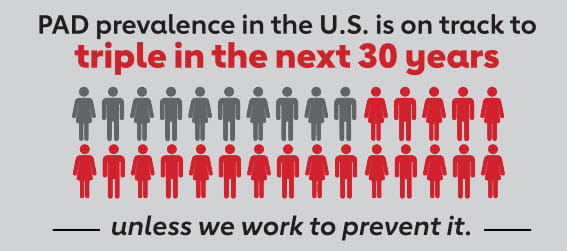Understand Your Risk for PAD

People who smoke and/or have Type 2 diabetes are at especially high risk for peripheral artery disease, or PAD. If you have risk factors for peripheral artery disease, get screened, even if you're not having symptoms.
PAD risk factors you can't control
Certain risk factors for PAD can't be controlled, including:
- Increasing age
- Age 65 and older
- Age 50 to 64 with risk factors for atherosclerosis, such as diabetes, a history of smoking or a family history of PAD after atherosclerosis
- Age 50 and younger with diabetes and at least one other risk factor for atherosclerosis
- Personal or family history of PAD, cardiovascular disease or stroke.
- Race. PAD is more common in Black people.
PAD risk factors you can control
You can manage or control the following risk factors:
- Cigarette smoking – Smokers may have almost three times the risk of PAD than nonsmokers. Use our guide to quitting smoking.
- Diabetes – Having diabetes puts you at greater risk of developing PAD as well as other cardiovascular diseases. Learn more about the risks and how to manage diabetes.
- High blood pressure – It's called "the silent killer" because it has no symptoms. Work with your health care professionals to monitor and control your blood pressure.
- High blood cholesterol – High cholesterol contributes to the build-up of plaque in the arteries (atherosclerosis), which can significantly reduce the blood's flow. Managing your cholesterol levels is essential to prevent or treat PAD.
- Physical activity – It increases the distance that people with PAD can walk without pain and helps decrease the risk of heart attack and stroke. Supervised exercise programs are one of the treatments for some people with PAD.
You can choose more than one risk factor to improve. Controlling only one isn’t as effective as taking care of all those you can control.






